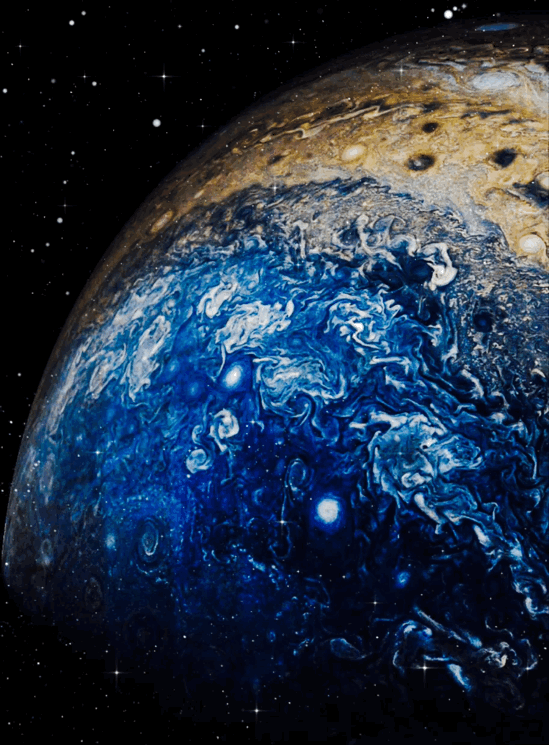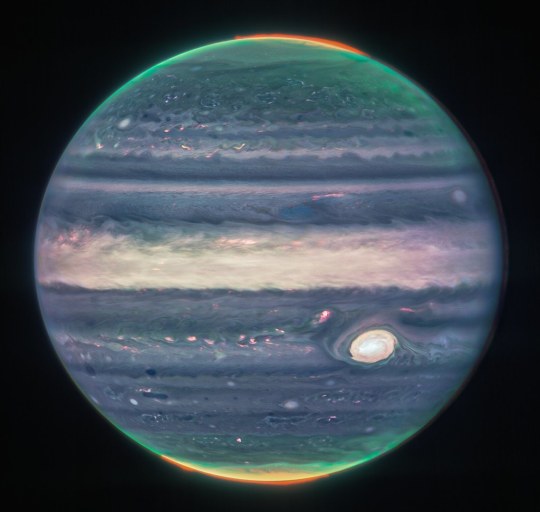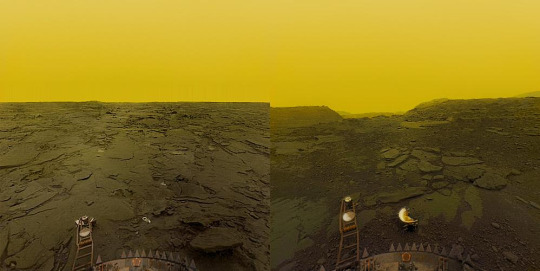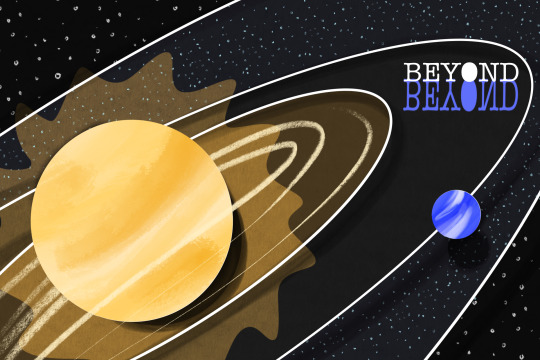#Solar System & Beyond
Text


🧡Jupiter Orbit 💙
#gifs (edits) made by me :)#assassin1513#space#space vibes#space aesthetic#lost in space#outer space#solar system#planets#jupiter#van gogh#glitter#to infinity and beyond#beyond the stars#infinity#astronomy#james webb space telescope#james webb#vincent van gogh#orbit#jupiter planet#jupiter pictures#jupiter photos#space magic#magical#mystical#stars#cosmos#void#blue
675 notes
·
View notes
Video
Hubble Uncovers a Celestial Fossil by NASA's Marshall Space Flight Center
Via Flickr:
This densely populated group of stars is the globular cluster NGC 1841, which is part of the Large Magellanic Cloud (LMC), a satellite galaxy of our Milky Way galaxy that lies about 162,000 light-years away. Satellite galaxies are bound by gravity in orbits around a more massive host galaxy. We typically think of the Andromeda Galaxy as our galaxy’s nearest galactic companion, but it is more accurate to say that Andromeda is the nearest galaxy that is not in orbit around the Milky Way galaxy. In fact, dozens of satellite galaxies orbit our galaxy and they are far closer than Andromeda. The largest and brightest of these is the LMC, which is easily visible to the unaided eye from the southern hemisphere under dark sky conditions away from light pollution. The LMC is home to many globular clusters. These celestial bodies fall somewhere between open clusters – which are much less dense and tightly bound – and small, compact galaxies. Increasingly sophisticated observations reveal the stellar populations and characteristics of globular clusters are varied and complex, and we have yet to fully understand how these tightly packed groups of stars form. However, there are certain consistencies across all globular clusters: they are very stable and hold their shape for a long time, which means they are generally very old and contain large numbers of very old stars. Globular clusters are akin to celestial ‘fossils.’ Just as fossils provide insight into the early development of life on Earth, globular clusters such as NGC 1841 can provide insights into very early star formation in galaxies. Credit: ESA/Hubble & NASA, A. Sarajedini #NASA #NASAGoddard #NASAMarshall #NASAGoddard #HubbleSpaceTelescope #HST #ESA #globularcluster Read more Read more about NASA’s Hubble Space Telescope NASA Media Usage Guidelines
#NASA#Goddard Space Flight Center#GSFC#Solar System & Beyond#ESA#European Space Agency#universe#space#astronomy#Marshall Space Flight Center#MSFC#Hubble Space Telescope#HST#Hubble#globular cluster#NGC 1841#star cluster#globular star cluster#stars#Watch
20 notes
·
View notes
Text
One of the elders being named saturn, and the fact that it's confirmed that one of the ancient weapons is a living person along with their planet names, I wonder if the ancient "weapons" were all living people/beings and if the three either defected or was a part of the same group as the elders way back?
There's also the whole thing with the sun too, as well
#one piece#one piece spoilers#egghead spoilers#one piece 1073#one piece unreleased#5 elders + 3 weapons gives us the original 8 planets#(not counting earth)#imu's theme could be connected to like... hm#either the missing earth element here or something vaster like the solar system-beyond?#assuming it keeps up with that kind of theme#we dont know the other elders titles but HMMM#giving the weapons planet names and an elder a planet name is just... its all coming together lol#ohhhhh i wanna know more about imu so so bad#is his motif the moon instead?#giving us a sun vs moon kinda deal that i thought would be saved for blackbeard?#which im still leaning on but hm#it's also fitting i think#like with the moon and the world government seeming straight forward at first#but then you look closer and see the dark side of it and the secrets [imu not being known to the public or anyone else besides#the higher uppers]#WAIT THE CELESTIAL DRAGONS ARE SPACE THEMED TOO#they literally wear space suits#ough
117 notes
·
View notes
Photo

A Peek Into Jupiter’s Inner Life by NASA's Marshall Space Flight Center Auroras and hazes glow in this composite image of Jupiter taken by the James Webb Space Telescope's Near-Infrared Camera (NIRCam). NIRCam has three specialized infrared filters that showcase details of the planet. Since infrared light is invisible to the human eye, the light has been mapped onto the visible spectrum: the auroras are mapped to redder colors, hazes to yellows and greens, and light reflected from a deeper main cloud to blues. Image credit: NASA, ESA, CSA, Jupiter ERS Team; image processing by Judy Schmidt. #NASA #STScI #jwst #jameswebbspacetelescope #NASAGoddard #NASAMarshall #planet #Jupiter Read more More about the James Webb Space Telescope NASA Media Usage Guidelines https://flic.kr/p/2nLdWAu
74 notes
·
View notes
Text
Happy Eclipse Day! FUCK the SUN! GO MOON!!!!!
#I love space!!!!!#I was on some map NASA made of the solar system to show you where the shadow would go etc and I kept zooming out because what the hell.#we are on planet earth …we have a MOON….we have the SUN#there are other PLANETS that are so far from us#and there’s MORE BEYOND all of that . THERE’S MORE#THERE{S MORE!!!! OUT THERE!!!!#anyway i internally went through all of that and then went back to my silly emails at work .
2 notes
·
View notes
Text
Law Of Assumption has got nothing to do with astrology. It is literally everyone's birthright, I don't care how shitty your birth chart looks like or what zodiac sign you are. Law Of Assumption is not unique to any specific 'star sign'.
#loa#law of assumption#random#random thought#did i just see an astro hoe talking about how only fixed signs come across loa?#yes i did and it annoyed me#loa isn't supposed to be limiting#it goes beyond the invisible restraints that the solar system's planets have on you... lol#yall wanna turn loassumption into law of attraction sooo bad and it makes you look dumb because they're soooo different#loassumption has got NOTHING to do with astrology. it literally beats EVERYTHING spiritual...#everyone on this planet is using the loassumption whether they know it or not#we've been manifesting our whole lives lol aint got nothing to do with astro crap
32 notes
·
View notes
Text
Raw Poetic — Space Beyond the Solar System (22nd Century Sound)

Photo by Earl Davis
youtube
Jason Moore AKA Raw Poetic and Earl Davis AKA Damu the Fudgemunk guide us on a kaleidoscopic two-hour trip. The duo embellishes Moore’s acute observational lyrics with hip hop, jazz, funk and classical music, creating cuts that ride loose conversational grooves reminiscent of boom bap’s heyday and the Native Tongue collective. Raw Poetic engages with the lived experience of Black America, drawing connections between street hassles and systemic oppression. He is unafraid to embrace the contradictions and complicity of the artist’s quest for freedom. On Space Beyond the Solar System, Raw Poetic and Damu celebrate the liberating potential of words and music. Endlessly inventive production features telling contributions from saxophonist Archie Shepp, Irreversible Entanglements bassist Luke Stewart and guitarist Pat Fritz.
“A Mile In My Head” encapsulates what makes the album so compelling. Part interior dialogue, part social critique, Moore maps his DC neighborhood accompanied by Shepp’s mindful solo and Stewart’s driving bass lines. After name-checking De La Soul and visiting his local record store, he reflects on the nation’s capital and his place in it, “Same old city/Same old city that was built by slaves/Now I can’t afford anything we made.” Then he stands back, and Shepp’s unadorned saxophone takes over before the beats & bass re-enter. A suite-like structure enhances the cinematic osmosis between the production and lyrics. Moore’s staccato, word-heavy flows are interspersed with spacious instrumental sections.
The album closes with “Antidote Island,” a 23-minute summation that feels like a hip hop version of Black Renaissance’s Body, Mind And Spirit in its exploration of the genius and tragedy of black creative history. Both an examination and an exhortation, it takes in snippets of old spirituals, cosmic jazz and gospel as Moore raps about the power of music, community and the cycle of life. Two repeated lines “Therefore whatever/Get what you wanna do” and “I scream fight the power/Yeah sure” find him caught between hope and frustration. An excerpt of Sinatra singing “But what good are memories?/They just seem to get in the way” suggests ennui is an unaffordable luxury when history is being actively subverted. On Space Beyond The Solar System Moore and Davis have created a powerful mnemonic and a wonderfully engaging musical adventure.
Andrew Forell
#raw poetic#space beyond the solar system#22nd century sound#andrew forell#albumreview#dusted magazine#Damu The Fudgemunk#archie shepp#luke stewart#hip hop#jazz
2 notes
·
View notes
Text
Super Earth
Explore TOI-715 b, a super-Earth in a distant solar system, and join the quest for alien worlds beyond the stars. 🌌🪐 #SpaceExploration
#Explore TOI-715 b#a super-Earth in a distant solar system#and join the quest for alien worlds beyond the stars. 🌌🪐#SpaceExploration
0 notes
Text
Exploring Our Solar System: A Comprehensive Guide.
Introduction
The cosmos, with its vast and mysterious expanse, has captivated human curiosity throughout the ages, urging us to look beyond the familiar boundaries of our terrestrial home. Our solar system, a captivating assembly of celestial bodies, has been a subject of continuous scientific exploration for centuries. In this detailed article, we embark on an enlightening journey, delving into…

View On WordPress
0 notes
Note
What do you mean by Venus floating cities?
I'm hoping to write a science fiction story about visiting Venus as part of the space race and I would love your input
Alright so the thing with Venus is that we're all very familiar with her horrible hell-death clouds and 900°F surface temperatures. We all understand the surface of Venus is not a fun place for humans to be.

But, nobody ever talks about the fact that ABOVE the hell-death clouds, Venus is a paradise. The most Earth-like environment we know of in the solar system, beyond Earth itself, is actually in the skies of Venus.
About 30 miles above the surface, the pressure is ~1 atmosphere, and the temperature ranges from 30 - 100°F, which is Happy Human™ standard pressure and temperature.
What's more, a breathable mix of oxygen and nitrogen provides over 60% the lifting power on Venus that helium does on Earth. In other words, a balloon full of human-breathable air would float to the habitable range of Venus's atmosphere. We could float a ship with the very air we breathe.
The other great thing about this is that it avoids one of the big problems with Mars colonization. On Mars, any habitat on the surface full of breathable air is vulnerable to leaks and explosive decompression, a la the Martian.

Floating on Venus, a balloon full of breathable air doesn't have a significant pressure difference between the inside and the outside. Which means, any leaks or tears would be very slow and manageable. You could fix that shit with duct tape!
Similarly, because the environment outside the balloon is so Earth-like, humans living there wouldn't need any big fancy pressurized suits for extravehicular work. We'd need air to breathe, maybe some heat protection, and protection against the acid rain. That's it.
Venus also provides the tools to keep us fed! It's atmosphere is made primarily of carbon dioxide, even above the dense horrible clouds. What likes carbon dioxide? Plants from Earth!! Lets grow FOOD on FLOATING PLATFORMS in the SKIES of VENUS.
This whole idea actually came out of a NASA effort exploring potential Venus colonization. The program was called HAVOC - the High Altitude Venus Operational Concept.
It hasn't really gone anywhere, and as far as I know there are no real plans to revisit it. Unfortunately, from a practicality standpoint, Mars is a much more viable target for human colonization. Not only is it better poised for outer solar system exploration, being farther away from the sun, but living on Venus would come with too many complicated contingencies. In the event of a major failure on Venus, you'd need to fly to another base, or fuck off all the way to orbit. I understand why people aren't really in a hurry to live somewhere where landing on the surface means certain death.
But that doesn't mean I won't be forever and always enamored by the skies of Venus. Here's one of the artist concepts to come out of HAVOC.

I want to be there.
#venus#nasa#space#space exploration#HAVOC#blimp#spost#venus my beloved#single most underrated planet#asked and answered
7K notes
·
View notes
Text

Idk, my mind wanders around in space sometimes
1 note
·
View note
Text
Hi this is pirate third acc! This blog manly focuses on objects beyond the solar system!
1 note
·
View note
Video
NASA’s Juno Exploring Jovian Moons During Extended Mission by NASA's Marshall Space Flight Center
Via Flickr:
After revealing a trove of details about the moons Ganymede and Europa, the mission to Jupiter is setting its sights on sister moon Io. NASA’s Juno mission is scheduled to obtain images of the Jovian moon Io on Dec. 15 as part of its continuing exploration of Jupiter’s inner moons. Now in the second year of its extended mission to investigate the interior of Jupiter, the solar-powered spacecraft performed a close flyby of Ganymede in 2021 and of Europa earlier this year. In this image, the volcano-laced surface of Jupiter’s moon Io was captured in infrared by the Juno spacecraft’s Jovian Infrared Auroral Mapper (JIRAM) imager as it flew by at a distance of was about 50,000 miles (80,000 kilometers) on July 5, 2022. Brighter spots indicate higher temperatures in this image. Image credit: NASA/JPL-Caltech/SwRI/ASI/INAF/JIRAM #NASA #MarshallSpaceFlightCenter #MSFC #Marshall #jpl #jetpropulsionlaboratory #nasamarshall #juno #nasajuno #Io Read more More about Juno NASA Media Usage Guidelines
#NASA#Marshall Space Flight Center#MSFC#Jet Propulsion Laboratory#JPL#Solar system and beyond#Juno#Jupiter#Space#planets#Io#flickr
1 note
·
View note
Video
NASA Finds Moon of Saturn Has Chemical That Could Form ‘Membranes’ par NASA's Marshall Space Flight Center
Via Flickr :
NASA scientists have definitively detected the chemical acrylonitrile in the atmosphere of Saturn’s moon Titan, a place that has long intrigued scientists investigating the chemical precursors of life. On Earth, acrylonitrile, also known as vinyl cyanide, is useful in the manufacture of plastics. Under the harsh conditions of Saturn’s largest moon, this chemical is thought to be capable of forming stable, flexible structures similar to cell membranes. Other researchers have previously suggested that acrylonitrile is an ingredient of Titan’s atmosphere, but they did not report an unambiguous detection of the chemical in the smorgasbord of organic, or carbon-rich, molecules found there. Now, NASA researchers have identified the chemical fingerprint of acrylonitrile in Titan data collected by the Atacama Large Millimeter/submillimeter Array (ALMA) in Chile. The team found large quantities of the chemical on Titan, most likely in the stratosphere — the hazy part of the atmosphere that gives this moon its brownish-orange color. Image credit: NASA/JPL/Space Science Institute Read more NASA Media Usage Guidelines
#NASA#NASA's#Marshall#Space#Flight#Center#Cassini#JPL#Jet#Propulsion#Laboratory#Solar#System#Beyond#Saturn#Titan#flickr
0 notes
Text
I just finished my last reading for my astronomy course and while I have had a surprising amount of fun with this subject, anything beyond this introductory stuff is evidently far too abstract for my tiny little brain to comprehend lmaooo
#i will stick to our solar system... don't wanna think about anything beyond that :')#that being said i used to be a very 'why explore space when the ocean is right there' kind of person#i have now changed my mind#space is cool as hell#still terrified of it but in an awe sort of way
0 notes
Text
Scientists have developed a new solar-powered system to convert saltwater into fresh drinking water which they say could help reduce dangerous the risk of waterborne diseases like cholera.
Via tests in rural communities, they showed that the process is more than 20% cheaper than traditional methods and can be deployed in rural locations around the globe.
Building on existing processes that convert saline groundwater to freshwater, the researchers from King’s College London, in collaboration with MIT and the Helmholtz Institute for Renewable Energy Systems, created a new system that produced consistent levels of water using solar power, and reported it in a paper published recently in Nature Water.
It works through a process called electrodialysis which separates the salt using a set of specialized membranes that channel salt ions into a stream of brine, leaving the water fresh and drinkable. By flexibly adjusting the voltage and the rate at which salt water flowed through the system, the researchers developed a system that adjusts to variable sunshine while not compromising on the amount of fresh drinking water produced.
Using data first gathered in the village of Chelleru near Hyderabad in India, and then recreating these conditions of the village in New Mexico, the team successfully converted up to 10 cubic meters, or several bathtubs worth of fresh drinking water. This was enough for 3,000 people a day with the process continuing to run regardless of variable solar power caused by cloud coverage and rain.
[Note: Not sure what metric they're using to calculate daily water needs here. Presumably this is drinking water only.]
Dr. Wei He from the Department of Engineering at King’s College London believes the new technology could bring massive benefits to rural communities, not only increasing the supply of drinking water but also bringing health benefits.
“By offering a cheap, eco-friendly alternative that can be operated off the grid, our technology enables communities to tap into alternative water sources (such as deep aquifers or saline water) to address water scarcity and contamination in traditional water supplies,” said He.
“This technology can expand water sources available to communities beyond traditional ones and by providing water from uncontaminated saline sources, may help combat water scarcity or unexpected emergencies when conventional water supplies are disrupted, for example like the recent cholera outbreaks in Zambia.”
In the global rural population, 1.6 billion people face water scarcity, many of whom are reliant on stressed reserves of groundwater lying beneath the Earth’s surface.
However, worldwide 56% of groundwater is saline and unsuitable for consumption. This issue is particularly prevalent in India, where 60% of the land harbors undrinkable saline water. Consequently, there is a pressing need for efficient desalination methods to create fresh drinking water cheaply, and at scale.
Traditional desalination technology has relied either on costly batteries in off-grid systems or a grid system to supply the energy necessary to remove salt from the water. In developing countries’ rural areas, however, grid infrastructure can be unreliable and is largely reliant on fossil fuels...
“By removing the need for a grid system entirely and cutting reliance on battery tech by 92%, our system can provide reliable access to safe drinking water, entirely emission-free, onsite, and at a discount of roughly 22% to the people who need it compared to traditional methods,” He said.
The system also has the potential to be used outside of developing areas, particularly in agriculture where climate change is leading to unstable reserves of fresh water for irrigation.
The team plans to scale up the availability of the technology across India through collaboration with local partners. Beyond this, a team from MIT also plans to create a start-up to commercialize and fund the technology.
“While the US and UK have more stable, diversified grids than most countries, they still rely on fossil fuels. By removing fossil fuels from the equation for energy-hungry sectors like agriculture, we can help accelerate the transition to Net Zero,” He said.
-via Good News Network, April 2, 2024
#water#water scarcity#clean water#saline#desalination#off grid#battery technology#solar power#solar energy#fossil fuels#water shortage#india#hyderabad#new mexico#united states#uk#united kingdom#good news#hope#aquifers
822 notes
·
View notes

